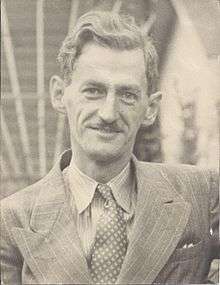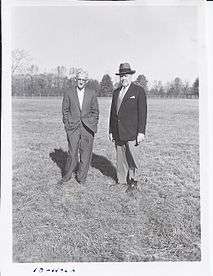Glenn Albert Black

Glenn Albert Black was an influential archaeologist of the United States who was among the first professionals to study Indiana prehistoric sites. He was born 18 August 1900 in Indianapolis, Indiana, and died 2 September 1964 in Evansville, Indiana.[1]
Black began serious archaeological work before there were many training opportunities in archaeology in the United States. He did not attend college, but was awarded an honorary Ph.d. by Wabash College in 1951. He is considered to have been the only professional archaeologist focusing on Indiana ancient history until the 1960s. He is primarily responsible for the identification of many Native American archaeological sites in the area, including the Angel Mounds, which he brought to national attention. It was designated a National Historic Landmark in 1964.[2] He was supported throughout his archaeological career by his friend Eli Lilly.
Black is best known for his posthumously published two-volume study of the Angel Mounds near Evansville, Indiana, and their cultural tradition. He operated a field school at the site. His innovative excavation techniques were partly adopted by the University of Chicago Field School, one of the few training programs in archaeological field techniques in the United States in the first half of the 20th century. Black is also notable for participating in a multidisciplinary investigation of the veracity of the Walam Olum creation account through archaeological means.[3]
In addition to leading and reporting on excavations, he served in the Society for American Archaeology as President (1941–1942), Vice President (1939–1940), and Treasurer (1947–1951). The Glenn A. Black Laboratory of Archaeology at Indiana University, established in 1971, is named for him.[1]
Early life
Glenn Albert Black was born August 18, 1900, in Indianapolis, Indiana. He attended public school through high school, then was forced to take on the role of head of household after the death of his father, John A. Black, in 1912. Black took a job as an estimating engineer for Fairbanks, Morse and Company. Taking on archaeology as a hobby, Black began to amass a collection of artifacts from prehistoric sites in Marion County, and studied the history of the state. He wrote to Dr. C. B. Coleman, director of the Indiana Historical Bureau, in the fall of 1930 to ask if his services would be accepted “if they were offered gratis.” The opportunity came when, in 1931, Fairbanks, Morse and Company decided to move to Wisconsin, and Black was forced to resign his position in order to stay in Indiana and support his family.[1]
Indiana Archaeology

In May, Black was hired to serve as a local guide to Warren K. Moorehead, who helped create archaeological programs for the study of the eastern part of the United States, as well as Eli Lilly and E. Y. Guernsey, as they assessed Indiana archaeological sites. On October 27, he married Ida May Hazzard. In the winter of 1931, Black was recommended by Moorehead to be sent to Greene County and begin surveys there. He was later sent to Columbus, Ohio, to study collections at the Ohio State Museum and do further field excavations. Black returned to Green County in 1932 for further excavations in conjunction with the Indiana Historical Bureau. In 1933, Black assisted on a survey of Dearborn and Ohio counties, recording sites such as Nowlin Mound. Black led excavations at Nowlin Mound, which began in 1934. Ida Black, who was also very interested in archaeology, was also active in the excavations at Nowlin Mound.[4] In 1936, Black began to the excavation of documented villages, believed to have been inhabited by Miami, Shawnee and Potawatomi people during the seventeenth and eighteenth centuries. He turned his attention to the Angel Mounds site, one of those surveyed in the 1931 trip.
Angel Mounds
The Indiana Historical Society bought the land of the Angel Mounds site in 1938 with a donation from Eli Lilly.[2] This was done to protect and preserve it for future research and education. In 1939, Glenn and Ida Black moved into a house on the property. As part of FDR’s New Deal, the Works Progress Administration began excavations of the site from 1939 to 1942 which would employ more than 200 people. These excavations allowed the training of young archaeologists, and a reoccurring field school was established which would continue until the summer of 1962. World War II affected excavation of the Angel Mounds site, which halted in 1941. In 1944, Black was appointed a lecturer in archaeology at Indiana University’s Department of Zoology. IU started research at the site in 1945, and control of Angel Mounds is transferred to the state of Indiana in 1946.[1]
Affiliation with Indiana University and Later Years
Indiana University established the Department of Anthropology in 1947, and Black moved to lecture within it.[5] He was awarded an honorary Doctor of Science from Wabash College in 1951, and retires from lecturing at IU in 1960. Until the 1960s, Glenn Black was seen as the only professional archaeologist practicing in the state of Indiana. From 1963-64, Black and the site team completed excavation of the large mound, which had been stopped by WWII. Black died September 2, 1964, of a heart attack in Evansville, Indiana. The Glenn A. Black Laboratory of Archaeology was established on IU’s campus in his memory with funds from Eli Lilly and Ida Black.[1] It opened April 21, 1971, and to this day continues the research, preservation and exhibition of Indiana’s history.
Publications
- Black, Glenn Albert. 1967. Angel Site, An Archaeological, Historical and Ethnological Study (with James H. Kellar). Indianapolis: Indiana Historical Society, 2 volumes.
Notes
- 1 2 3 4 5 "Glenn A. Black Laboratory of Archaeology". Retrieved 14 September 2011.
- 1 2 "ANGEL MOUNDS". Friends of Angel Mounds. Retrieved 2017-02-17.
- ↑ Griffin, James B. (1955-03-01). "Walam Olum or Red Score: The Migration Legend of the Lenni Lenape or Delaware Indians: A New Translation, Interpreted by Linguistic, Historical, Archaeological, and Physical Anthropological Studies. by". Indiana Magazine of History. ISSN 1942-9711.
- ↑ "Going into Winter Quarters are the Prehistoric Dwellers in Indiana, Having Been Discovered by Archaeologists Digging in Dearborn County". The Indianapolis News. October 13, 1934.
- ↑ "Department of Anthropology | Indiana University Bloomington". www.indiana.edu. Retrieved 2017-02-17.
References cited
- Angel Mounds Friends of Angel Mounds.
- Griffin, James B.. 1955. Walam Olum or Red Score "Indiana Magazine of History," vol. 51, issue 1, pg. 59-65.
- Kellar, James H.. 1966. Glenn A. Black, 1900-1964, "American Antiquity", vol. 31, pg. 402–405.
- Kellar, James H.. 1971. Glenn A. Black. Indiana University Bloomington.